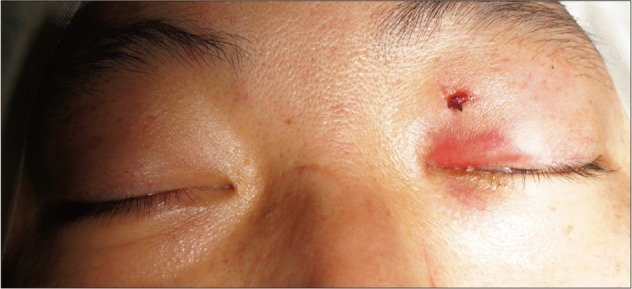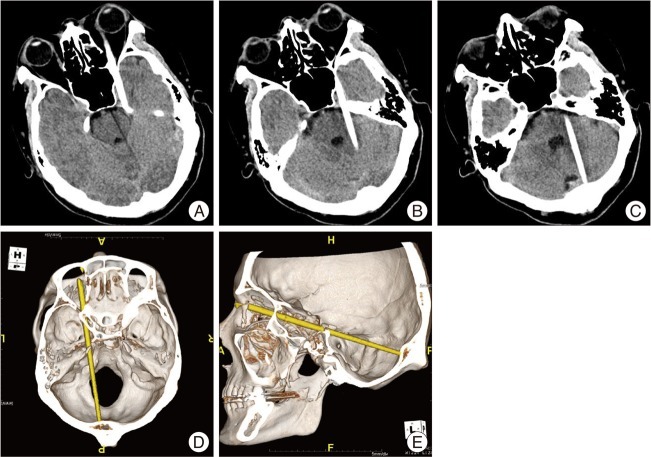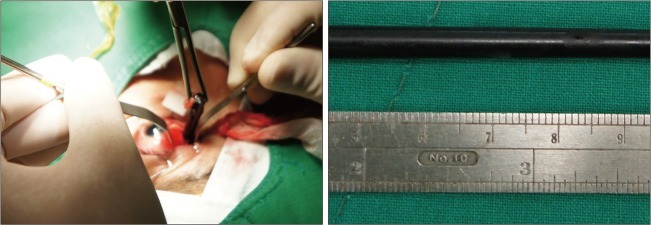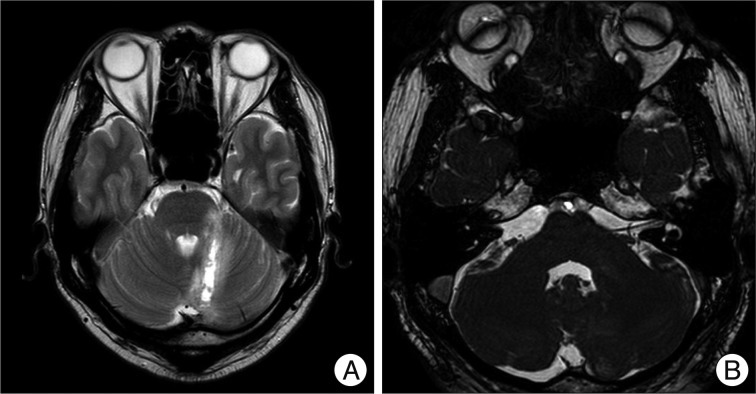J Korean Neurosurg Soc.
2012 Oct;52(4):414-416. 10.3340/jkns.2012.52.4.414.
Transorbital Penetrating Intracranial Injury by a Chopstick
- Affiliations
-
- 1Department of Neurosurgery, Yeungnam University College of Medicine, Daegu, Korea. shkim@med.yu.ac.kr
- KMID: 2190663
- DOI: http://doi.org/10.3340/jkns.2012.52.4.414
Abstract
- A 38-year-old man fell from a chair with a chopstick in his hand. The chopstick penetrated his left eye. He noticed pain, swelling, and numbness around his left eye. On physical examination, a linear wound was noted at the medial aspect of the left eyelid. Noncontrast computed tomography (CT) study showed a linear hypodense structure extending from the medial aspect of the left orbit to the occipital bone, suggesting a foreign body. This foreign body was hyperdense relative to normal parenchyma. From a CT scan with 3-dimensional reconstruction, the foreign body was found to be passing through the optic canal into the cranium. The clear plastic chopstick was withdrawn without difficulty. The patient was discharged home 3 weeks after his surgery. A treatment plan for a transorbital penetrating injury should be determined by a multidisciplinary team, with input from neurosurgeons and ophthalmologists.
Keyword
MeSH Terms
Figure
Reference
-
1. Carothers A. Orbitofacial wounds and cerebral artery injuries caused by umbrella tips. JAMA. 1978; 239:1151–1152. PMID: 628067.
Article2. Chibbaro S, Tacconi L. Orbito-cranial injuries caused by penetrating non-missile foreign bodies. Experience with eighteen patients. Acta Neurochir (Wien). 2006; 148:937–941. discussion 941-942. PMID: 16763734.
Article3. De Villiers JC, Sevel D. Intracranial complications of transorbital stab wounds. Br J Ophthalmol. 1975; 59:52–56. PMID: 1125159.
Article4. Di Roio C, Jourdan C, Mottolese C, Convert J, Artru F. Craniocerebral injury resulting from transorbital stick penetration in children. Childs Nerv Syst. 2000; 16:503–506. discussion 507. PMID: 11007502.
Article5. du Trevou MD, van Dellen JR. Penetrating stab wounds to the brain : the timing of angiography in patients presenting with the weapon already removed. Neurosurgery. 1992; 31:905–911. discussion 911-912. PMID: 1436415.6. Dunn IF, Kim DH, Rubin PA, Blinder R, Gates J, Golby AJ. Orbitocranial wooden foreign body : a pre-, intra-, and postoperative chronicle : case report. Neurosurgery. 2009; 65:E383–E384. discussion E384. PMID: 19625895.7. Eidsness R, Coupal DJ, Kelly ME, Hattingh S. Traumatic orbital injury. J Trauma. 2007; 62:1286–1287. PMID: 17495739.
Article8. Fezza J, Wesley R. The importance of CT scans in planning the removal of orbital-frontal lobe foreign bodies. Ophthal Plast Reconstr Surg. 1999; 15:366–368.
Article9. Fujimoto S, Onuma T, Amagasa M, Okudaira Y. [Three cases of an intracranial wooden foreign body]. No Shinkei Geka. 1987; 15:751–756. PMID: 3670545.10. Ginsberg LE, Williams DW 3rd, Mathews VP. CT in penetrating craniocervical injury by wooden foreign bodies : reminder of a pitfall. AJNR Am J Neuroradiol. 1993; 14:892–895. PMID: 8352161.11. Hansen JE, Gudeman SK, Holgate RC, Saunders RA. Penetrating intracranial wood wounds : clinical limitations of computerized tomography. J Neurosurg. 1988; 68:752–756. PMID: 3357035.
Article12. Kahler RJ, Tomlinson FH, Eisen DP, Masel JP. Orbitocranial penetration by a fern : case report. Neurosurgery. 1998; 42:1370–1373. PMID: 9632198.13. Kasamo S, Asakura T, Kusumoto K, Nakayama M, Kadota K, Atsuchi M, et al. [Transorbital penetrating brain injury]. No Shinkei Geka. 1992; 20:433–438. PMID: 1570067.14. Kazarian EL, Stokes NA, Flynn JT. The orbital puncture wound : intracranial complications of a retained foreign body. J Pediatr Ophthalmol Strabismus. 1980; 17:247–250. PMID: 7411338.
Article15. Kitakami A, Kirikae M, Kuroda K, Ogawa A. Transorbital-transpetrosal penetrating cerebellar injury--case report. Neurol Med Chir (Tokyo). 1999; 39:150–152. PMID: 10193148.16. Knerlich F, Verheggen R. Neurological picture. Feeding cats might be dangerous : penetrating orbital and brain injury without neurological deficits. J Neurol Neurosurg Psychiatry. 2005; 76:1359. PMID: 16170076.
Article17. Lunetta P, Ohberg A, Sajantila A. Suicide by intracerebellar ballpoint pen. Am J Forensic Med Pathol. 2002; 23:334–337. PMID: 12464807.
Article18. Maruya J, Yamamoto K, Wakai M, Kaneko U. Brain abscess following transorbital penetrating injury due to bamboo fragments--case report. Neurol Med Chir (Tokyo). 2002; 42:143–146. PMID: 11936059.
Article19. Matsumoto S, Hasuo K, Mizushima A, Mihara F, Fukui M, Shirouzu T, et al. Intracranial penetrating injuries via the optic canal. AJNR Am J Neuroradiol. 1998; 19:1163–1165. PMID: 9672032.20. Miller CF, Brodkey JS, Colombi BJ. The danger of intracranial wood. Surg Neurol. 1977; 7:95–103. PMID: 835079.21. Reddy HS, Chang E. Images in clinical medicine. Penetrating orbital trauma. N Engl J Med. 2008; 358:e3. PMID: 18199858.22. Smely C, Orszagh M. Intracranial transorbital injury by a wooden foreign body : re-evaluation of CT and MRI findings. Br J Neurosurg. 1999; 13:206–211. PMID: 10616594.
Article23. Turbin RE, Maxwell DN, Langer PD, Frohman LP, Hubbi B, Wolansky L, et al. Patterns of transorbital intracranial injury : a review and comparison of occult and non-occult cases. Surv Ophthalmol. 2006; 51:449–460. PMID: 16950246.
Article24. Walid MS, Yelverton JC, Robinson JS Jr. Penetrating orbital trauma with internal carotid injury. South Med J. 2009; 102:116–117. PMID: 19077762.
Article25. Wesley RE, Anderson SR, Weiss MR, Smith HP. Management of orbital-cranial trauma. Adv Ophthalmic Plast Reconstr Surg. 1987; 7:3–26. PMID: 3502746.
- Full Text Links
- Actions
-
Cited
- CITED
-
- Close
- Share
- Similar articles
-
- Homicidal Transorbital Intracranial Injury by a Metallic Chopstick: a Case Report
- Surgical Cases of Penetrating Brain Injury by Foreign Body
- Massive Subarachnoid Pneumocephalus due to Transorbital Intracranial Penetrating Injury: A Case Report
- Fencing Knife-Induced Transorbital Penetrating Brain Injury: A Case Report
- Brain Abscess Following a Transorbital Penetrating Injury by a Wooden Stick: A Case Report





